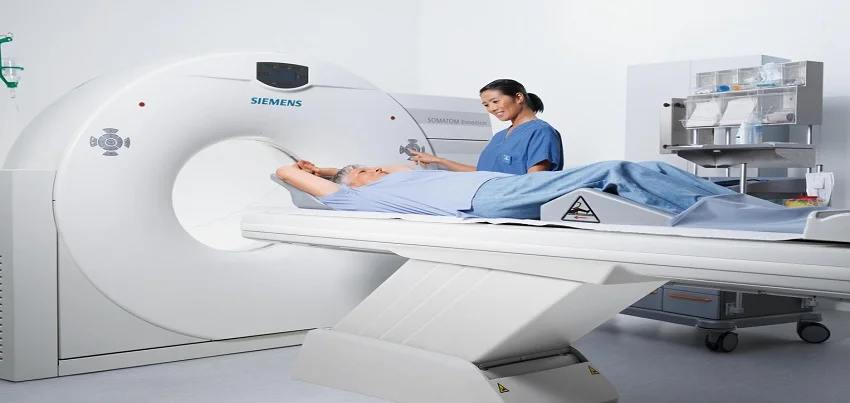PrognoHealth – Corporate Health & Wellness Specialist
Contact Us
+91 9510650660
Email Us
corpsales@prognohealth.com
Contact Us
+91 9510650660
Email Us
corpsales@prognohealth.com
CT Scan Of The Thoracic Spine Test
A CT scan of the thoracic spine is a diagnostic imaging test that helps physicians evaluate the bones, discs, and surrounding soft tissues of the middle and upper back. In this blog post, we’ll discuss how the test is conducted, any necessary preparation, common symptoms for ordering the test, and what patients can expect from the results.
Firstly, let’s look at how the test is conducted. A CT scan of the thoracic spine typically involves the use of X-rays and computer technology to create detailed, cross-sectional images of the body. During the test, the patient lies on a table that slides into a machine called a CT scanner. The scanner emits X-rays and rotates around the body to capture images from multiple angles. These images are then processed by a computer to create a three-dimensional image of the thoracic spine.
As with any medical imaging test, there may be some preparation required. Depending on the reason for the test, patients may be asked to fast for a certain period of time beforehand, avoid taking certain medications, or drink a contrast material that helps to enhance the images. It’s important for patients to follow their doctor’s instructions carefully in order to ensure the most accurate and reliable results.
Now, let’s explore the common symptoms that may lead to ordering a CT scan of the thoracic spine. This type of test is often used to diagnose a variety of conditions affecting the middle and upper back, including herniated discs, spinal stenosis, degenerative disc disease, and spinal fractures. Patients experiencing persistent back pain, weakness, numbness, or tingling in the middle or upper back may be candidates for a thoracic spine CT scan.
In terms of how long the test takes, a CT scan of the thoracic spine typically takes less than an hour from start to finish. However, patients may be asked to arrive early for preparation or may experience delays depending on the specific facility and equipment being used.
Finally, let’s discuss what patients can expect from the results of a thoracic spine CT scan. The images produced during the test can provide a detailed look at the bones, discs, and surrounding soft tissues of the middle and upper back, allowing physicians to identify any abnormalities or issues that may be causing symptoms. Based on the results of the test, doctors may recommend further testing, such as an MRI or a biopsy, or may develop a treatment plan that may include medication, physical therapy, or surgery.
In summary, a CT scan of the thoracic spine is a valuable diagnostic tool that can help physicians evaluate a range of conditions affecting the middle and upper back. Patients should follow their doctor’s instructions carefully to prepare for the test and can expect to receive results that provide important information about their health and well-being. As with any medical test, it’s important to discuss any concerns or questions with your doctor in advance.
Blog Categories
Top rated products
-
 FB Health Checkup I
Rated 5.00 out of 5
FB Health Checkup I
Rated 5.00 out of 5₹3,000.00Original price was: ₹3,000.00.₹1,770.00Current price is: ₹1,770.00. -
 Healthy Life Male
Rated 0 out of 5
Healthy Life Male
Rated 0 out of 5₹18,000.00Original price was: ₹18,000.00.₹9,900.00Current price is: ₹9,900.00. -
 Complete Men’s Health Profile – 40+ – 136 Parameters
Rated 0 out of 5₹2,899.00
Complete Men’s Health Profile – 40+ – 136 Parameters
Rated 0 out of 5₹2,899.00 -
 OFFICE STAFF PACK II
Rated 0 out of 5
OFFICE STAFF PACK II
Rated 0 out of 5₹2,400.00Original price was: ₹2,400.00.₹1,320.00Current price is: ₹1,320.00. -
 FB Health Checkup III
Rated 0 out of 5₹11,000.00
FB Health Checkup III
Rated 0 out of 5₹11,000.00
About Us
Progno Health is a Corporate Health & Wellness Specialist providing services to Pan India. We offer Pre-employment Health Checkup Packages, Annual Health Checkup Packages, Executive Health Checkup Packages, Occupational Health Checkup Packages, and other Health & Wellness Services.




